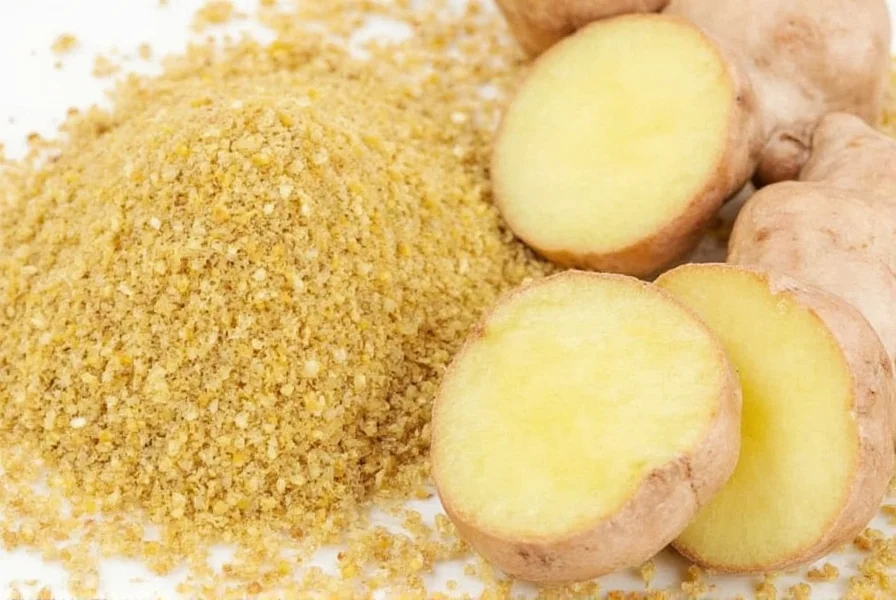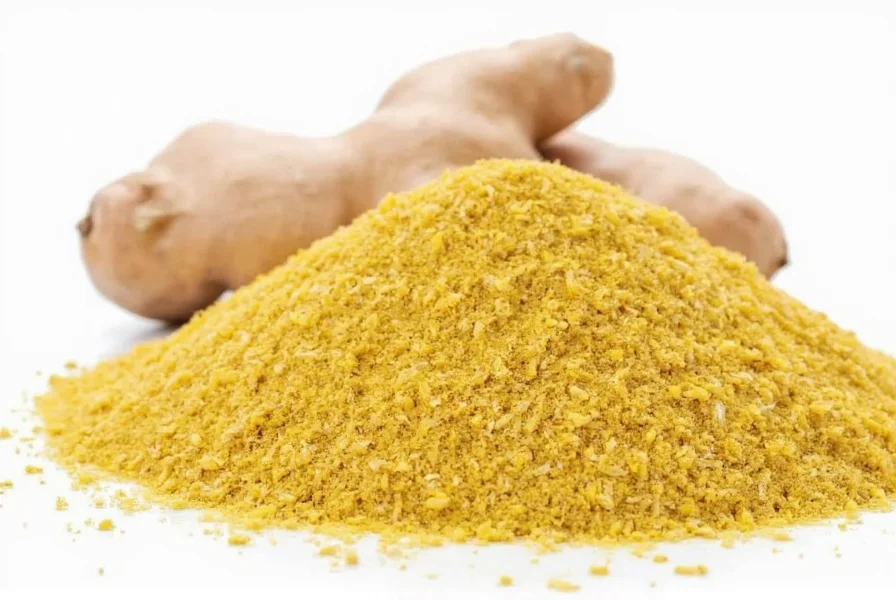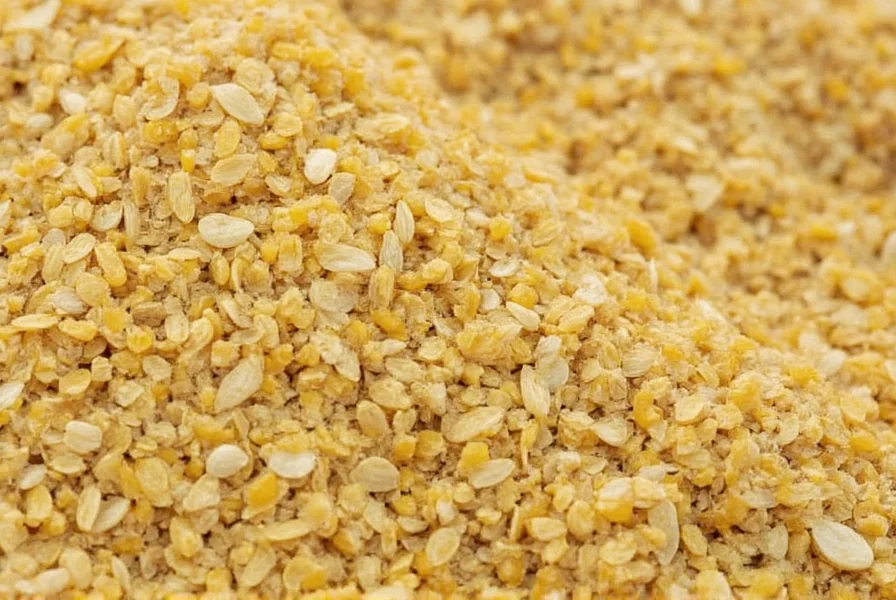Understanding the properties and proper applications of ground ginger can significantly enhance your culinary creations. This versatile spice brings distinctive warmth to both sweet and savory dishes while offering notable health benefits backed by scientific research.
What Exactly Is Ground Ginger?
Ground ginger begins as fresh ginger rhizomes (often mistakenly called roots) that undergo a specific processing method. After harvesting, the ginger is peeled, sliced thinly, and dehydrated at low temperatures to preserve its essential oils and compounds. Once completely dry, the ginger pieces are finely ground into a uniform powder.
The drying process concentrates ginger's active compounds, particularly gingerols, which transform into shogaols during dehydration. This chemical change creates ground ginger's distinctive warm, slightly sweet flavor profile that differs from fresh ginger's brighter, more pungent taste.

Ground Ginger vs Fresh Ginger: Key Differences
Understanding the differences between these two forms is essential for proper substitution and optimal flavor development in recipes:
| Characteristic | Ground Ginger | Fresh Ginger |
|---|---|---|
| Flavor Profile | Warmer, more concentrated, slightly sweet | Brighter, sharper, more pungent |
| Potency | More concentrated (use less) | Less concentrated (use more) |
| Best Uses | Baking, spice blends, long-cooking dishes | Stir-fries, fresh sauces, beverages, quick cooking |
| Shelf Life | 2-3 years when properly stored | 2-3 weeks refrigerated |
How to Substitute Ground Ginger for Fresh (and Vice Versa)
Many home cooks wonder about proper substitution ratios when a recipe calls for one form but they only have the other. The general conversion guideline is:
- ¼ teaspoon ground ginger = 1 tablespoon fresh grated ginger
- 1 teaspoon ground ginger = 1 inch fresh ginger (about 5 tablespoons grated)
However, this ground ginger substitution ratio isn't always perfect due to the flavor differences between the two forms. In baking recipes, ground ginger works exceptionally well as its flavor distributes evenly throughout the batter. For dishes where ginger's bright, fresh quality is essential (like many Asian stir-fries), fresh ginger remains the superior choice.
Culinary Applications of Ground Ginger
Ground ginger shines in specific cooking applications where its unique properties provide advantages over fresh ginger:
In Baking
Ground ginger's even distribution makes it ideal for baked goods like gingerbread, snickerdoodles, and spice cakes. Its warm notes complement other baking spices like cinnamon and cloves, creating complex flavor profiles that develop beautifully during baking.
In Spice Blends
Ground ginger is a staple in many global spice mixtures including:
- Garam masala (Indian cuisine)
- Chinese five-spice powder
- Cajun seasoning
- Pumpkin pie spice
In Long-Simmering Dishes
For soups, stews, and braises that cook for extended periods, ground ginger maintains its flavor better than fresh ginger, which can become bitter when cooked too long.

Health Benefits of Ground Ginger
Research supports several health benefits associated with ginger consumption, whether fresh or ground. The dehydration process actually increases certain beneficial compounds:
- Digestive aid: Multiple studies confirm ginger's effectiveness in reducing nausea and improving digestion
- Anti-inflammatory properties: Gingerols and shogaols may help reduce inflammation markers
- Antioxidant content: Ground ginger maintains significant antioxidant capacity despite dehydration
- Pain relief: Some research suggests ginger may help reduce muscle pain and menstrual discomfort
For therapeutic benefits, most studies use doses equivalent to ¼-1 teaspoon of ground ginger daily. However, consult with a healthcare provider before using ginger for medicinal purposes, especially if taking blood thinners.
Proper Storage for Maximum Freshness
To preserve ground ginger's flavor and potency:
- Store in an airtight container away from light and heat
- Keep in a cool, dark cupboard (not above the stove)
- Use within 2-3 years for optimal flavor (though safe indefinitely)
- Check freshness by aroma—fresh ground ginger has a strong, spicy scent
Unlike fresh ginger, ground ginger doesn't require refrigeration. Exposure to moisture is its primary enemy, as it can cause clumping and flavor degradation.
Common Questions About Ground Ginger
Can I substitute ground ginger for fresh ginger in recipes?
Yes, but with important considerations. Use ¼ teaspoon ground ginger for every tablespoon of fresh grated ginger. Remember that ground ginger has a warmer, less bright flavor, so this substitution works best in baked goods and long-cooking dishes rather than recipes where fresh ginger's bright quality is essential.
Is ground ginger as healthy as fresh ginger?
Ground ginger retains many beneficial compounds, though the profile differs slightly. The dehydration process converts some gingerols to shogaols, which may have enhanced anti-inflammatory properties. Both forms offer significant health benefits, but fresh ginger contains higher levels of certain volatile compounds that are reduced during drying.
Why does my ground ginger taste bitter?
Bitter ground ginger usually indicates it's past its prime. Ground ginger gradually loses its essential oils and can develop off-flavors over time. Properly stored ground ginger should have a warm, spicy-sweet aroma. If it smells musty or has little scent, it's time to replace it. Exposure to moisture or heat accelerates flavor degradation.
Can I make my own ground ginger at home?
Yes, making homemade ground ginger ensures maximum freshness. Peel fresh ginger, slice thinly, dehydrate at 135°F (57°C) for 8-12 hours until brittle, then grind in a spice grinder or mortar and pestle. Store in an airtight container. Homemade ground ginger has a more vibrant flavor but shorter shelf life than commercial products.
What's the difference between ground ginger and ginger powder?
These terms are generally interchangeable in culinary contexts. Both refer to dried, powdered ginger root. Some manufacturers may use "ginger powder" for a finer grind, but there's no standardized distinction. Check ingredient labels to ensure you're getting pure ginger without additives.











 浙公网安备
33010002000092号
浙公网安备
33010002000092号 浙B2-20120091-4
浙B2-20120091-4